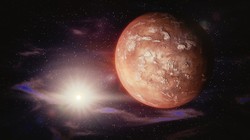Terraforming, a subject that has inspired many writers throughout the ages. A lot of scientists are searching for ways to change a planet in such a way that it starts to resemble Earth. The scientifically crusade to find different methods to change the surface of a planet has been going on since human kind was able to send rockets to space. Astronomers and science fiction fans hope to create a second Earth using terraformation techniques.

Terraformation of Mars
by herat123
This article will explain what terraformation is and will give some of the main problems of this proces.
What is terraformation?
Terraformation describes all actions whose purpose is to change a planet in such a way that it resembles that of the Earth. This does not only includes changing the atmosphere and climate of a planet, but also all other things that are essential for human survival. The ultimate goal of terraformation is to make a previous inhabitable planet habitable for humans. This way humans would be able to spread over different planets, to decrease the overpopulation problems.
Why Mars?
Distance
Most terraformation methods have never been tested in space. Most things in the universe are extremely far apart. It would take tremendous amounts of time should there arise problems while testing these new methods on a planet other than Mars (or Venus). Travelling to Mars takes around six months (depending on Earths position relative to Mars), so even Mars is a vast distance away from Earth. Choosing another planet would even result in a bigger loss of time.
Temperature
The temperature on Mars is relatively bearable for humans. The average temperature on the surface is around minus 60 degrees Celsius. This seems cold, and it is, but there are spacesuits that can handle this temperature. This is one of the reasons Mars is a better candidate for terraforming than Venus, although Venus is closer to the Earth. The temperature on the surface of Venus averages around 450°C, a completely unbearable temperature.
Water
In 2015 scientists working for the NASA found water on Mars. This is a huge advantage should we try to terraform Mars. Because of this, there is no need to create new water, a hard and potentially long process. The only downside is that, because there is an abundance of salt and other minerals dissolved in it, the water on Mars isn't directly usable.
What problems to solve?
Atmosphere, temperature, pressure and ozone layer
The atmosphere of Mars differs from that on Earth. It's smaller and is composed out of other elements. It contains around 95% (0.1%) CO2 , 3% Nitrogen (78%) and 1.6% (1%) argon. The other 0.4% consists out of hydrogen, oxygen (21%) and other gasses. The values in between parentheses are the values that can be found on Earth. Besides the difference in composition there is another problem: the atmosphere of Mars is polluted by small dust particles. When trying to terraform Mars, changing the balance of the atmosphere could be a huge step forward. Not only would the atmosphere become liveable for humans, it would also increase the surface temperature to more likeable temperatures. The pressure on the planet would become more like the pressure on Earth and there would form an equally good ozone layer.
Gravitational pull
The gravitation on Mars is around 62% lower than the gravitation on Earth. Scientists aren't sure about the long term effects of living on a planet with such a low gravitational pull. This could become a big hindrance should there arise problems.
Magnetosphere
Contrary to Earth, Mars doesn't have a magnetosphere. The magnetosphere is some kind of magnetic field that surrounds the Earth and protects it from dangerous particles. These particles, emitted by our sun, would strip the atmosphere from a planet. Because Mars doesn't have a magnetosphere, it isn't protected from these particles. This would result in an ever decreasing atmosphere and would be deadly for humans.
It will take a long time before Mars becomes a second Earth. But, who knows, maybe human kind starts living on Mars in a hundred+ years.
Sources:
http://www.kuuke.nl/wp/zonnestelsel/Mars/wat-is-de-temperatuur-van-Mars/
https://en.wikipedia.org/wiki/Terraforming_of_Venus
http://www.hln.be/hln/nl/961/Wetenschap/article/detail/2470636/2015/09/28/NASA-vindt-vloeibaar-water-op-Mars.dhtml
http://www.kuuke.nl/wp/zonnestelsel/venus/wat-is-de-temperatuur-van-venus/
http://science.howstuffworks.com/terraforming1.htm
http://www.universetoday.com/22587/atmosphere-of-Mars/
https://en.wikipedia.org/wiki/Effect_of_spaceflight_on_the_human_body
http://www.scientificamerican.com/article/origin-of-oxygen-in-atmosphere/
Images: Pixabay
You might also like
All About the Big Bang TheoryThe universe got created according to the principles of Big Bang theory. Like...


 The Fermi paradox explainedon 04/15/2016
The Fermi paradox explainedon 04/15/2016

Comments
Indeed, but the atmosphere problem could be solved. One possible solution could be the production of factory's on the surface of Mars. These would create greenhouse gasses that would improve the atmosphere's thickness and increase the temperature on the surface.
The water is mostly frozen solid, so by increasing the temperature it could become a fluid again. (Still, there is no certainty if there is enough water on the planet to sustain a big amount of life.)
About the magnetic field: yes, this is the biggest problem, and I don't think there is a solution for that yet. Mars has a solid on the inside, in contrary to Earth, which results in not having a magnetic field/ magnetosphere.
Mars has already lost most of its atmosphere, and much of its water. Mars has a major problem in not having a magnetic field.